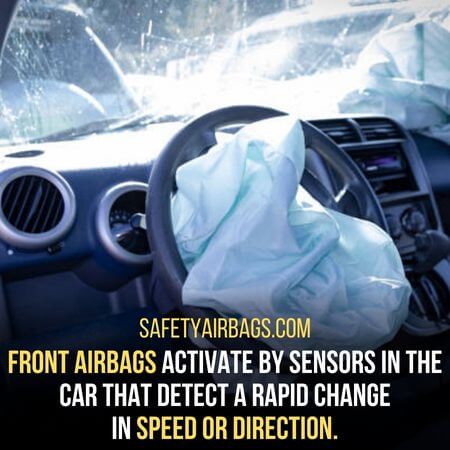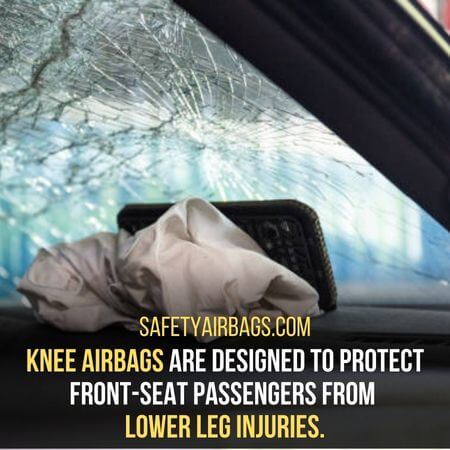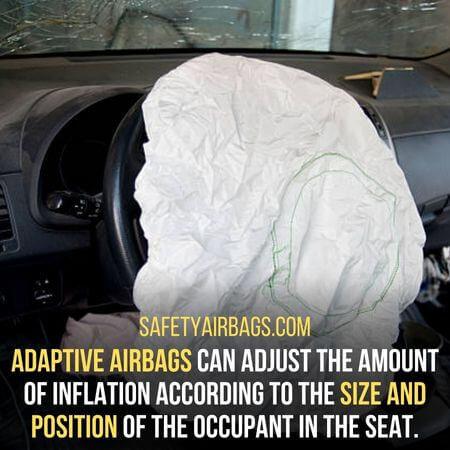What are the different types of airbags? Airbags are a key safety because they protect you from serious injury and even death during an impact.
What Will I learn
Airbags provide a cushion for your body in a crash to absorb some of the shocks. They can save lives by preventing traumatic injuries.
History Of Airbags And How They Have Evolved Over Time
Airbags have existed since the 1950s but weren’t widely used until the 1980s. Since then, airbag technology has advanced significantly.
In the early days, airbags were limited to frontal impacts. There wasn’t much in terms of safety features.

But today’s airbags come with a variety of features. These include side airbags, roll-sensing technology, and inflatable seatbelts.
There are also different types of airbags to protect different parts of the body. For example, there are knee airbags to protect the legs—and torso airbags to protect the chest.
Advancement in airbag technology has also allowed for more advanced features. These include adaptive deployment and dynamic control.
Adaptive Deployment & Dynamic Control:
The deployment of airbags is an important aspect to consider. This will determine how the airbag functions.
Airbags deploy by explosives that create a force that pushes the bag into its position. They protect against injuries like this.
Adaptive deployment allows the airbags to deploy at different speeds. Depending on the severity of the impact, which can help reduce injuries in some cases.
Dynamic control is a feature that adjusts the pressure of the airbag. Based on how far away an occupant is from the airbag.
This feature can help reduce potential injuries due to airbag deployment. In addition, airbags’ continual innovation is helping keep drivers safe on the roads.
They are sure to remain a crucial part of automotive safety for many years to come.
It is important to remember that airbags are only one part of a comprehensive safety system. It is important always to wear a seatbelt while driving.
Wearing a seatbelt and having the right airbags can help keep you safe on the roads. And it reduces any potential injuries in case of an accident.
Detailed – Types Of Air Bags:
The most common type of airbag is the frontal airbag. When a car crashes head-on into another vehicle or object, it deploys from the steering wheel.
Side airbags are in the doors and seat frames. And they are used to protect passengers in side collisions.
The knee airbag is beneath the dashboard and helps protect a driver’s legs in a crash. Other airbags, such as air curtain bags deployed from the roofline, are also available.
They protect passengers seated on either side of the car to protect during a rollover accident.
Airbags provide much-needed protection in the event of a crash. But they can also pose a risk if not maintained.
Like all other safety features in cars, ensuring your airbags are up to date, and working is important.
1. Front Airbags:
These are the most common airbags used to inflate when an impact occurs. They provide cushioning for the driver to reduce the risk of serious injury.
Front airbags activate by sensors in the car that detect a rapid change in speed or direction. Which indicates an impact has taken place.
The force of deployment determines according to the severity of the accident.
And can range from a few hundred miles per hour for minor collisions. To thousands of miles per hour for more serious impacts.
Comparison Of Driver-Side And Passenger-Side Front Airbags:
Driver-side airbags are larger and deploy with more force. This is because drivers experience more severe impacts during a collision.
They tend to bear the brunt of any impact. Passenger-side airbags provide passenger cushioning in a secondary capacity after a driver-side airbag has been deployed.

Moreover, they are designed to deploy with less force than their driver-side counterparts. This is because passengers—in most cases—experience less severe impacts than drivers.
Advanced Front Airbags And Depowered Airbags:
Advanced front airbags protect all passengers, regardless of size or position. In addition, these airbags deploy with additional force than standard airbags.
Depowered airbags are designed to deploy with less force than standard airbags. As a result, they reduce the risk of facial injuries.
Depowered airbags can also be adjusted based on several factors. These can include occupant size and seating position to reduce the risk of injury further.
2. Side Airbags:
Side airbags protect passengers in the event of a side collision. In addition, these airbags offer protection for the head and chest. But may also be referred to as thorax or side curtain airbags.
Side airbags protect passengers from side-impact collisions. However, traditional seat belts may not provide enough protection against severe injury during collisions.
This makes side airbags an essential safety feature. Side airbags deploy along the driver and passenger door panels.
They provide a cushioning barrier between the occupants and outside forces. Side airbags deploy from the roof or door panel and inflate when necessary.
Torso Airbags And Head-Protecting Airbags:
Torso airbags are located on the side of the seat and deploy downward to protect the chest and abdomen.
They have to cushion for extra protection. This helps reduce the risk of injury from being thrown forward during an impact or collision.
Head-protecting airbags deployed from above the window and door panel. They provide additional protection for the head and neck in case of a side impact.
They are usually positioned to protect the occupant’s head. But they can also be designed to protect the length of their body, from shoulder to hip.
Benefits And Limitations Of Side Airbags:
Side airbags are most beneficial for those sitting in the front seat. Since crashes from the side of a vehicle tend to be particularly dangerous.
These airbags often provide the best protection for front-seat passengers. However, there are some limitations to the effectiveness of side airbags.
For example, if the passenger is not seated during impact. It may not provide the necessary protection.
Side airbags may not be enough to protect from a particularly severe crash. Therefore, it is important for drivers and passengers alike to always wear their seat belts.
Side airbags can be key in providing added protection during an impact. But, they should not rely on as a sole source of protection; other safety, such as seat belts, are also vital.
3. Curtain Airbags:
Curtain airbags protect in the event of a side impact. They are typically located above the doors and along both sides of the vehicle’s interior.
They deploy downwards to shield passengers’ heads in an accident. In addition, they provide extra protection for passengers’ heads and necks.
They work by inflating and deploying from their storage above the door frames. They work by using sensors to detect an incoming impact.
They create a cushioned barrier between the window glass and the passengers. This type of airbag is essential in protecting passengers during a side-on collision.
They help reduce the impact’s force and spread it over a larger area.
Furthermore, curtain airbags are especially helpful for those who cannot move. This is because their heads or bodies are away from an incoming impact due to a disability.
Comparison Of Curtain Airbags To Other Types Of Airbags:
So, curtain airbags tend to deploy more slowly than other airbags, such as side airbags.
They can protect a person’s torso and head. At the same time, curtain airbags are better suited for protecting the head and upper body.
Moreover, they tend to be less expensive than other airbags. Finally, curtain airbags occupy less space in the vehicle when compared to side airbags.
This means more passengers can fit into a car with curtain airbags installed.
Effectiveness Of Curtain Airbags In Preventing Injuries In Rollover Accidents:
When it comes to rollover accidents, curtain airbags are effective in protecting occupants.
Also, it protects the head and upper body areas. This may be more likely to sustain injuries during a rollover accident.
However, they have been found to reduce the number of fatalities by as much as 40 percent in the event of a rollover accident.
Some curtain airbags also include side impact protection to reduce the risk of injury further.
In addition, curtain airbags can provide extra protection during high-speed impacts.
They deploy more quickly and forcefully than standard airbags. Thus, they keep passengers from being thrown around the vehicle’s interior.
4. Knee Airbags:
Knee airbags are another supplemental system designed to protect—and front-seat passengers from lower leg injuries in a frontal impact.
The knee airbag is located under the dashboard on the side closest. Here the driver sits, usually on the left side.
Generally depends on the make and model of the vehicle. Generally, though, they are designed to deploy before the front airbags inflate.

It reduces lower-leg injuries that can occur in a frontal collision. In addition, knee airbags are effective at reducing fatalities during frontal crashes.
Comparison Of Knee Airbags To Other Types Of Airbags:
Knee airbags are similar to front airbags in that they both deploy during a frontal crash. But knee airbags are typically smaller than front airbags.
Side curtain airbags are different. They provide protection for the head and upper body instead of the legs.
They also deploy from the ceiling rather than from the dashboard or door.
Knee airbags are different because they deploy from the lower part of the dashboard. And protect the knees and legs.
This type of airbag help reduces lower-leg injuries, such as broken bones, which can occur during a frontal crash.
Benefits And Limitations Of Knee Airbags:
On the plus side, they improve occupant safety in frontal collisions. And they can help reduce the severity of injuries.
On the negative side, knee airbags can be difficult to deploy in some collisions. And may block access to other safety features such as seatbelts or shoulder straps.
They may also interfere with airbag deployment for other parts of the body, such as the head or chest.
5. Rear-Seat Airbags:
Rear-seat airbags protect the rear-seat passenger. However, they may be more vulnerable in an accident due to their lack of visibility and seatbelt access.
These bags deploy from the headliner. And provide cushioning against the impact of a frontal collision.
Different Types Of Rear-Seat Airbags:
Rear-seat airbags come in two different types. The first type is a full-side curtain airbag, and the second is a half-side.
Full-side curtain airbags provide coverage for both front and rear passengers. Half-side curtain airbags protect only the rear passengers.
With either type of the airbag, the passenger is protected from head and neck injuries in the event of an accident.

Moreover, rear-seat airbags can be a supplemental restraint system during a rollover.
This helps to reduce injuries that are common in such incidents. Additionally, they help keep passengers from being thrown into their seatbelts and out of their seats.
Effectiveness Of Rear-Seat Airbags In Preventing Injuries In Accidents:
Rear-seat airbags protect passengers in the back seat in a frontal collision. They deploy from the headliner or ceiling. And provide cushioning against the impact of a crash.
This type of airbag benefits passengers who may not be wearing seatbelts. It provides an extra layer of protection to help reduce the severity of their injuries.
Rear-seat airbags can support those who are safe in seatbelts during a crash. A study was conducted using real-world crashes.
It was found that the injury risk for rear passengers was reduced by more than 20%. In addition, the risk of serious injuries was reduced by more than 30% when rear-seat airbags were present.
While these results are promising, further research needs to be conducted. For example, to fully understand the effectiveness of rear-seat airbags.
In the meantime, drivers need to follow safety protocols. And ensure that all passengers are secured in their seat belts before driving.
This will help minimize potential injuries should an accident occur.
6. Pedestrian Airbags:
Pedestrian airbags are a new technology that reduces the severity of injuries. However, pedestrians sustain it in the event of an accident.
These types of airbags are in the front end of the vehicle. And will deploy if sensors detect an impact on a pedestrian.
The cushioning airbags can protect pedestrians from head, neck, and chest injuries. However, pedestrian airbags are still a new technology and are not found in all vehicles yet.
They are becoming common as manufacturers look for ways to make cars safer.
It is an important development that can save lives by reducing the severity of injuries pedestrians sustain in crashes.
This technology is a testament to how far car safety has come in recent years. And how much safer cars can be with the right airbags.
By continuing to push forward these advancements. We can make our roads even safer for everyone.
Comparison Of Pedestrian Airbags To Other Types Of Airbags:
Front airbags protect the driver and passenger in the front seats of a car. They deploy when the vehicle experiences an impact by cushioning them from any possible injuries.
Side airbags protect in the event of a side-impact collision. They are in the doors or pillars of a vehicle. And deploy when sensors detect pressure from an external impact.
Pedestrian airbags provide extra protection for people walking near cars. These airbags deploy if a car is about to strike a pedestrian.
It cushions them from any possible injuries. These systems use radar, cameras, and other sensors to detect pedestrians in the car’s path.
The airbag then deploys to protect them from any impact on the car.
Benefits And Limitations Of Pedestrian Airbags:
Pedestrian airbags have been a great addition to vehicle safety systems. Also, they can potentially save lives in the case of an accident.
These airbags are usually triggered when a vehicle travels at or below 30 miles per hour. This means they will not deploy if a collision occurs at higher speeds.
It also requires the sensors to detect pedestrians accurately. It can be difficult in certain conditions, such as bad weather or low lighting.
The airbag is not able to protect pedestrians completely from a collision. As a result, they are still vulnerable to injury.
In addition, the airbags may become damaged during deployment. It can be expensive and time-consuming to replace.
Despite these limitations, pedestrian airbags are invaluable to vehicle safety systems.
Pedestrian airbags are expensive. In addition, these types of airbags deploy at low speeds. Therefore, they are best suited for protecting from lower-speed impacts rather than high-speed ones.
Other limitations include difficulty in detecting pedestrians at night and foggy conditions.
Despite these limitations, pedestrian airbags have been a great addition to vehicle safety systems as they help protect pedestrians from serious injuries.
They are especially useful for protecting children who may not be aware of traffic rules or their surroundings.
7. Adaptive Airbags:
Adaptive airbags are a type of airbag that can adjust the amount of inflation according to the size and position of the occupant in the seat.
This helps cut injuries from hard impacts and provides protection. The downside is that airbags are expensive and unavailable in many vehicles.
Adaptive airbags are an advanced type of airbag system. They’re designed to protect the driver and passengers better.

They adjust their inflation rate based on the size and weight of each occupant. As a result, they deploy more force on larger people and less force on small ones.
This helps ensure that everyone in the car is protected regardless of their position.
Adaptive airbags also deploy differently depending on the type of collision. They do so by providing more protection when a side impact occurs.
Furthermore, they can even detect if someone is not wearing a seatbelt. And will adjust their deployment accordingly.
Comparison Of Adaptive Airbags To Other Types Of Airbags:
Pedestrian airbags are designed to deploy in a collision with a pedestrian. Rear-facing airbags protect passengers who are seated back.
Some other differences include the deployment speed. For example, adaptive airbags deploy much faster than other types due to their increased complexity.
Adaptive airbags are also designed to provide more protection against side impacts. However, standard airbags may be more effective at providing frontal protection.
Benefits And Limitations Of Adaptive Airbags:
Adaptive airbags provide enhanced safety for all passengers. It includes those who may not be wearing seatbelts.
They also allow the airbag to deploy based on the type of collision by providing additional protection in cases such as side impacts.
Some critics have argued that these types of airbags can increase injury. For instance, children and the elderly are more vulnerable to airbag-related injuries.
In addition, adaptive airbags can be expensive to install. And need regular maintenance to ensure they are operating.
Despite these potential drawbacks, adaptive airbags remain an important tool for providing greater safety for all passengers in a collision.
8. Smart Airbags:
Smart airbags represent the latest generation of airbag technology. These airbags use sensors to adjust their deployment in response to a crash.
These include an occupant’s size and weight, seat position, and type of collision. This allows them to protect all occupants regardless of seating position.
Aside from better protection, these airbags can also reduce the risk of injury. Smart airbags use less inflation fostandardaditional, making them less likely to cause injury.
Smart airbags can also be programmed to deploy differently depending on the type of crash and the occupant’s position in the vehicle.
This allows them to provide greater protection for all occupants.
How Smart Airbags Work And Their Purpose In A Vehicle
Smart airbags are designed to deploy when sensors in the vehicle detect an impact. And they can be adjusted based on the severity of the collision.
This allows them to provide tailored protection for every occupant in a crash. Some systems even use cameras to detect the position of occupants in the vehicle and deploy airbags accordingly.
The purpose of smart airbags is to reduce the risk of standard ditional airbags’ depmuchamount of force, which can be dangerous in some scenarios. Sm rt airbags are designed to provide tailored protection based on each crash scenario.
They reduce the risk of injury to occupants.
Smart airbags are increasingly being used in new vehicles. As a result, automakers look for ways to improve safety and reduce the risk of occupant injuries.
Technology is becoming more affordable and w despread. More drivers will benefit from the added protection smart airbags offer.
Comparison Of Smart Airbags To Other Types Of Airbags:
Smart airbags protect every occupant of the vehicle. This makes them more effective than traditional airbags.
Traditional ones deploy regardless of the impact’s severity or the occupant’s size and weight.
Smart airbags take this one ste further. Using sensors to detect whether the seat is occupied and how much pressure is on it.
This allows the airbags to deploy with the appropriate force for a given situation. They do so by providing greater protection for heavier occupants in the front seats.
Side-impact airbags design to protect against side impacts, such as when a car is struck by another vehicle.
Benefits And Limitations Of Smart Airbags:
Smart airbags use sensors to detect the size and weight of p ssengers. This allows them to adjust the deployment force according to the occupants’ size and weight.
They ensure that even smaller occupants receive appropriate protection during an accident.
However, this technology also has its li itations. For instance, if the sensors are not calibrated correctly.
The airbag may deploy with too much force and cause injury to occupants. In addition, smart airbags may fail to deploy when necessary due to a malfunctioning sensor.
Conclusion:
Smart airbags are an important safety feature in modern vehicles. They help provide optimal protection for occupants, adapting to their size and weight.
However, this technology is not infallible and may sometimes ma function. So it’s important to be aware of the limitations when choosing a vehicle with a smart airbag.
Airbags have various forms and protect vehicle occupants during an accident. Standard airbags deploy with a fixed force, providing adequate protection to most passengers.
Airbags have come a long way in providing safety to vehicle occupants. And they continue to be an integral part of automotive design.
